Hey drone enthusiasts! Keeping up with the Drone Registration in Thailand in 2024 rules feels like navigating a rollercoaster—thrilling yet unpredictable, especially with the ever-changing guidelines. It’s crucial to have the most current and accurate information in the dynamic landscape of the Land of Smiles. Well, you’re in luck because I’m here to guide you through the latest on Drone Registration in Thailand, and ensure you’re fully prepared for your aerial adventures.
A word of caution: flying your drone in Thailand without adhering to the proper registration processes can lead to severe consequences. We’re talking hefty fines and the possibility of a not-so-pleasant stay in Thai detention facilities. For enthusiasts keen on capturing Thailand’s beauty from above, remember, you’ll need two essential registrations— one with the National Broadcasting and Telecommunications Commission (NBTC) for frequency use, and another with the Civil Aviation Authority of Thailand (CAAT) for pilot certification.
As drone popularity skyrockets, more tourists are tempted to bring their high-flying pals to Thailand. However, it’s crucial to familiarize yourself with the specific Drone Registration requirements for bringing and operating drones (UAVs or RPAs) within the country.
The rule from the NBTC is straightforward: all drones operating in Thailand must be registered. Neglect this, and you’re looking at a potential five-year jail sentence or a fine up to 100,000 THB (about 2850 USD). For tourists, yes, you can bring your drones, but keep them on the ground until you’ve completed your registration with the NBTC or CAAT. This is the key to enjoying your drone flights in Thailand without any legal hitches. So, let’s dive into the specifics of Drone Registration in Thailand and get you ready to fly legally and safely!
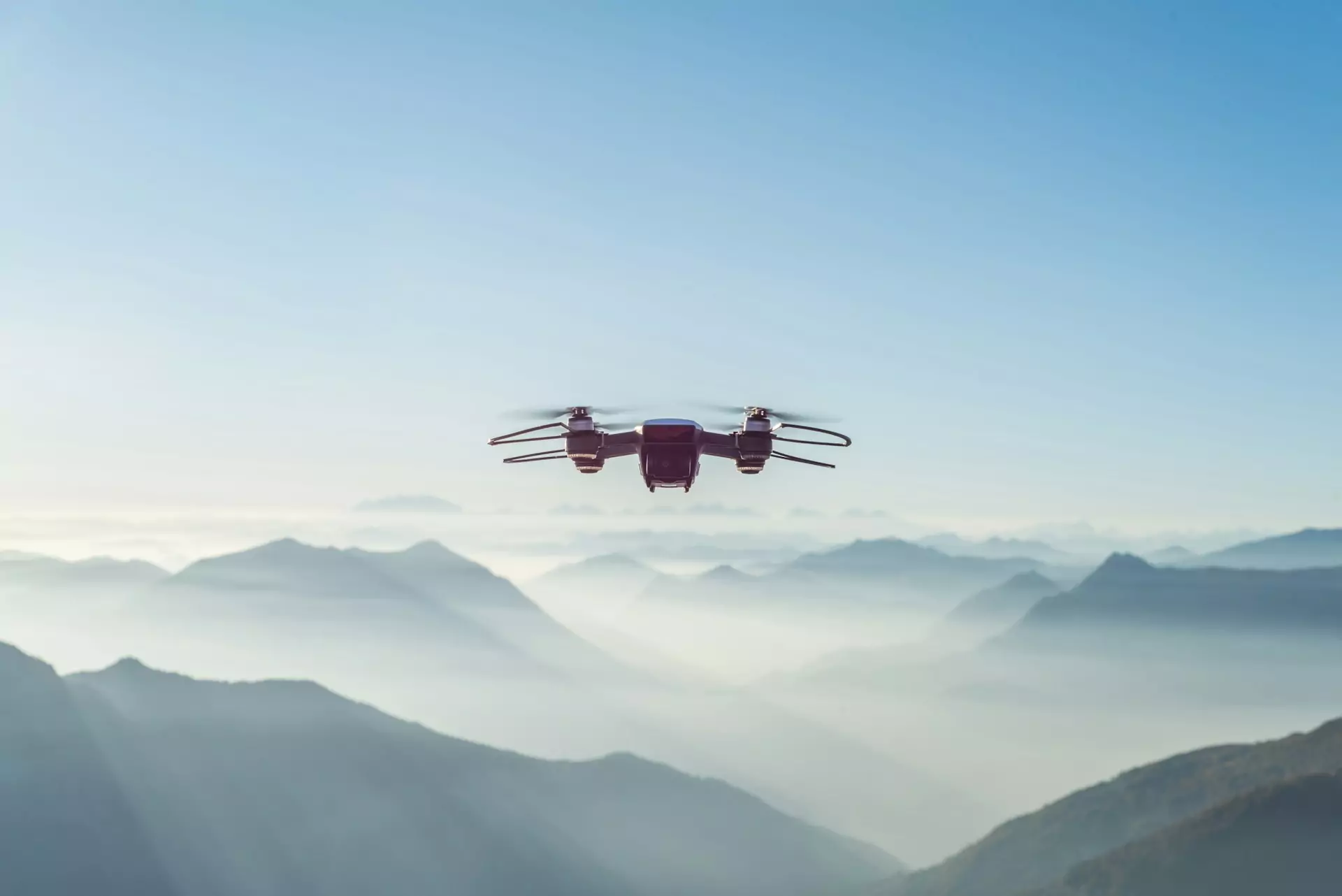
Obtaining a Tourist Visa
Your journey to legally fly drones in Thailand kicks off with getting that all-important tourist visa. Here’s the lowdown:
Visa Options
- Visa on Arrival (VOA): If you’re opting for VOA, be ready to tackle both CAAT and NTBC applications after touching down in Thailand. It’s a two-step dance, folks.
- E-Visa: Planning ahead? Great! You can apply for an e-visa online or in person. Check your eligibility at Thai e-Visa.
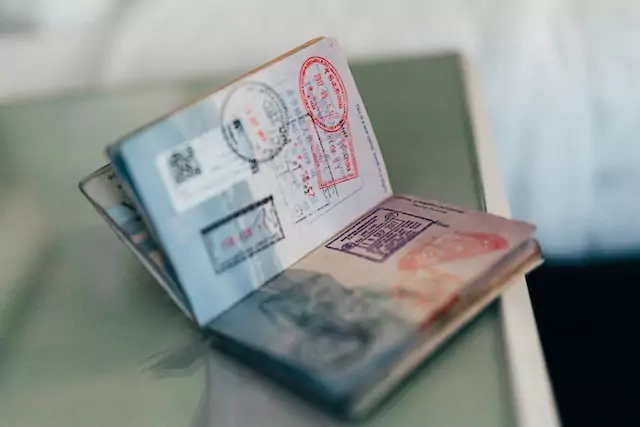
CAAT Online Drone Registration in Thailand Process
The cool part? You can start the CAAT application from anywhere, even before landing in Thailand. Just have your visa handy and drone information for the online upload.
NTBC Online Drone Registration in Thailand Process
Here’s the catch – NTBC requires not only your visa but also the entry stamp. This means your NTBC application can only kick off once you’re physically in the Land of Smiles. But hey, you can still prep all your docs in advance.
Pro Tips:
- For those flying in with VOA, buckle up for some post-arrival paperwork.
- E-visa holders, ensure you check the eligibility and choose the right application method.
- Have all your documents prepared in advance for a smooth online application process.
In the next steps, we’ll dive into insuring your drone, the CAAT online application process, and the NTBC online application process. So, stay tuned for more drone registration wisdom!
Insuring Your Drone
Now, let’s talk about safeguarding your drone with some insurance mojo before diving into the CAAT and NTBC applications. Here’s the lowdown:
Drone Insurance Limit
CAAT requires an insurance coverage of at least 1 million THB (approx. 28,500 USD), so make sure you select a suitable option.
Drone Insurance Options
You’ve got choices. You can either roll with a Thai company like FEIC (prices range from 1599 to 5999 THB per year, depending on coverage). They’re cool, but you don’t have to go this route.
Our Friendly Pick – Coverdrone

We found a gem named Coverdrone. Why? Well, they’re super flexible. You can get insured for the exact number of days you need. Plus, they’ve got your back if you want to cover other equipment. Bonus: We snagged a month of coverage for around 6 USD. Affordable and friendly – our kind of insurance.
Drone Insurance Documents
Here’s the secret sauce – save those insurance documents like they’re treasure. You’re going to need them for the upcoming CAAT and NTBC applications. Keep them handy, and your drone will thank you.
Pro Tips:
- Don’t break the bank on insurance. Find a plan that suits your needs.
- If you’re all about options and flexibility, Coverdrone might be your new best friend.
- Keep those insurance docs in a safe digital space. You’ll be pulling them out for the next steps.
CAAT Registration
Alright, drone enthusiasts, time to buckle up for the CAAT registration rollercoaster! Follow these steps to get your drone officially on the map in Thailand.
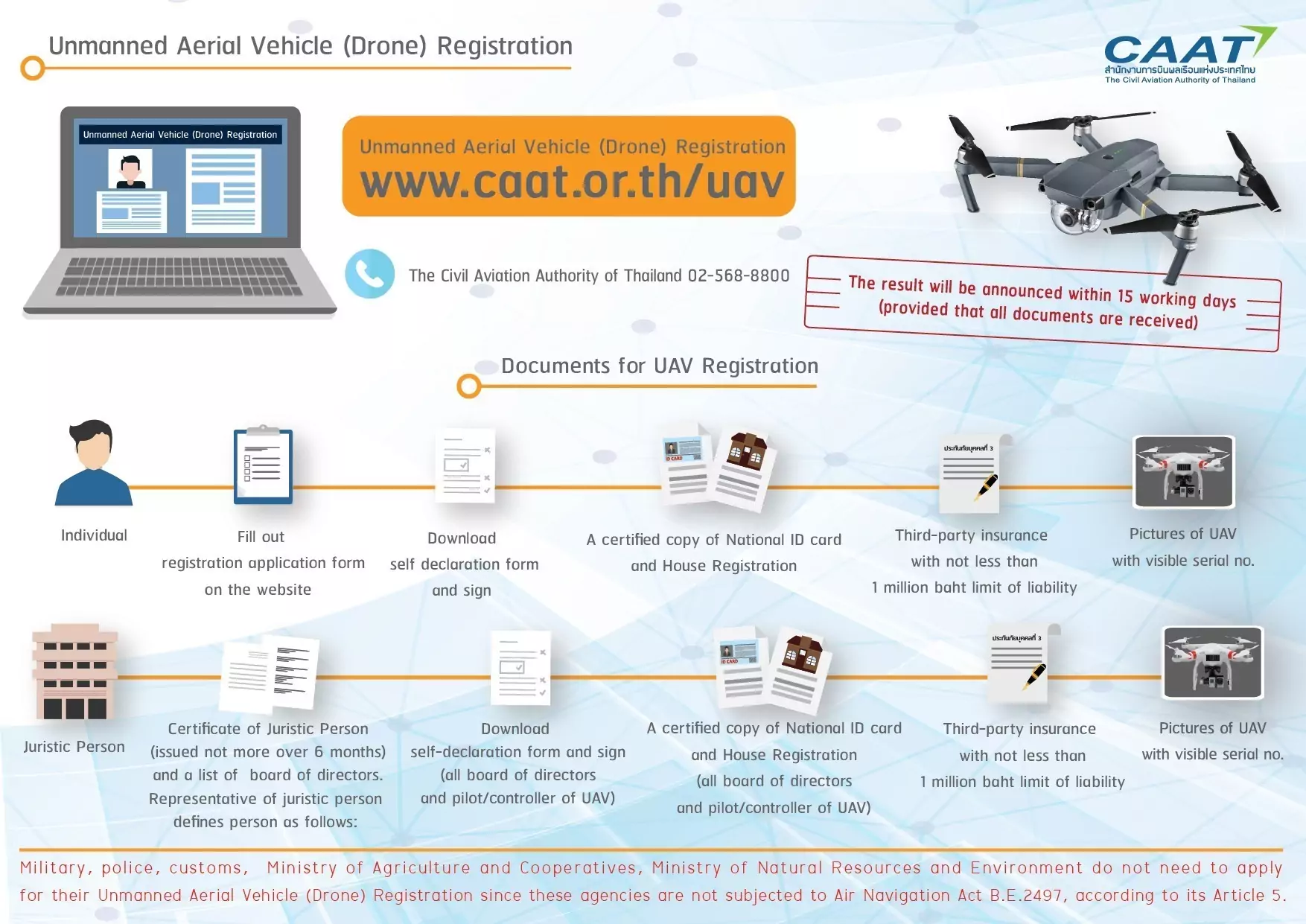
The registration process with CAAT, as mentioned on the website, should take around 15 working days. However, we received the CAAT approval in only 7 working days. The process is valid for two years.
First Step: Get your paperwork ready
You’ll need a self-declaration form, and you can find the template here.
Second Step: Go to the Online Application Portal
Head over to the CAAT online application portal at https://uav.caat.or.th/index.php.
Third Step: Registration Form
Once you’re on the CAAT website, register and fill out the online form. Here’s the info you’ll need:
Personal Details: Name, passport number, email, phone number, date of birth, age, nationality, and home address.
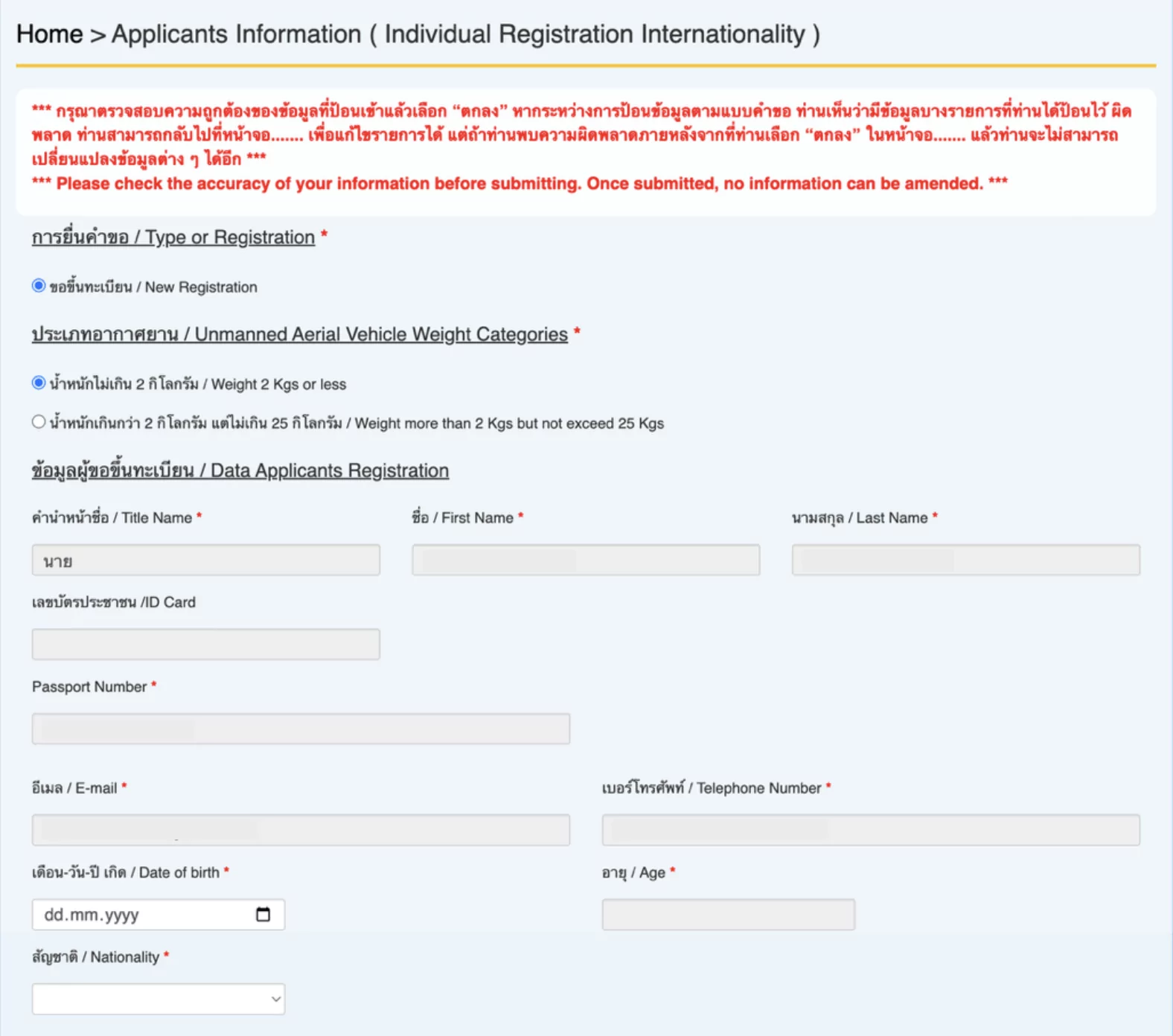
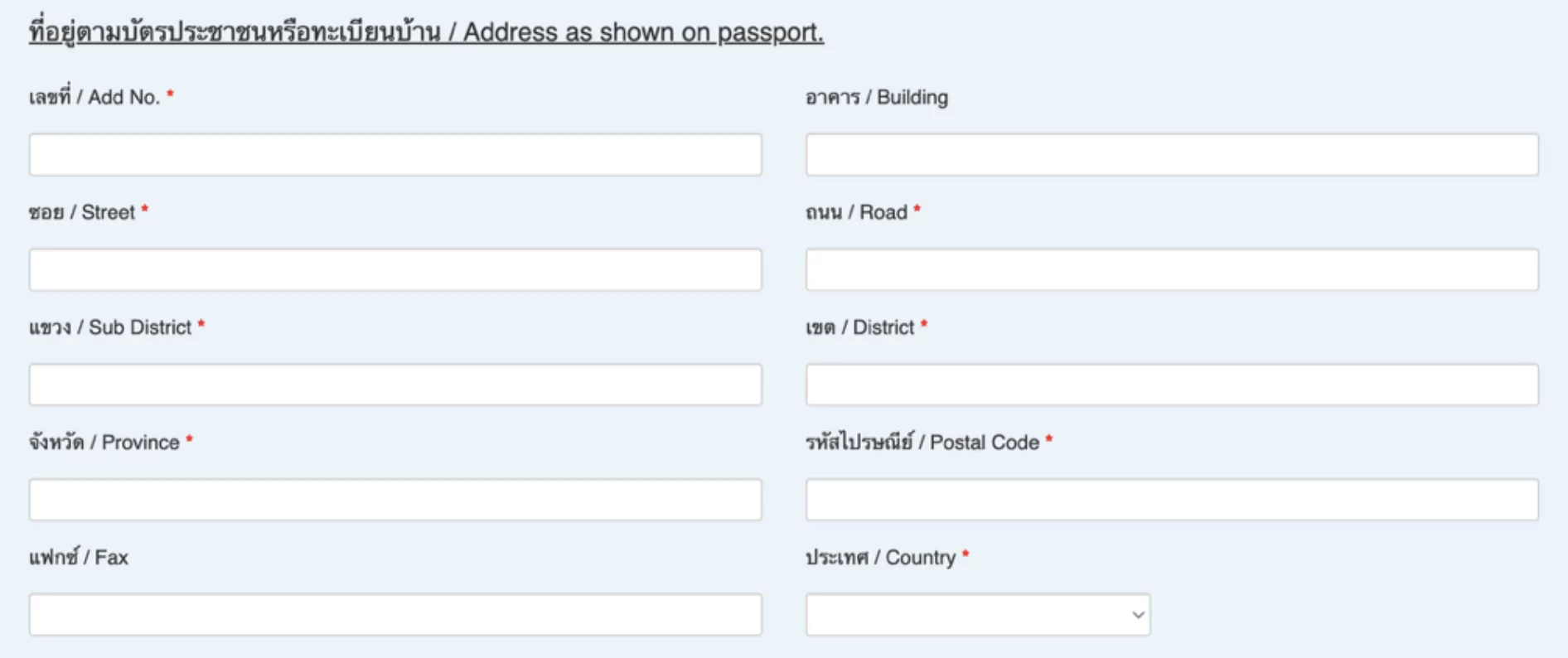
Drone Details: Brand, model, weight in kg, equipment list, and the all-important serial number (check your drone for this).

Purpose: I chose “recreation and sports,” and if you do the same, they’ll likely throw in “Photography, filming, or TV program” automatically.

Pilot Information: Add your details and, if applicable, the details of any other pilots. Specify if they’re foreigners or locals.

Insurance Info: Type of insurance (e.g., unidentified controller), policy number, insurance company, coverage limit in THB, insurance period (start and end date), and again, the drone’s serial number.
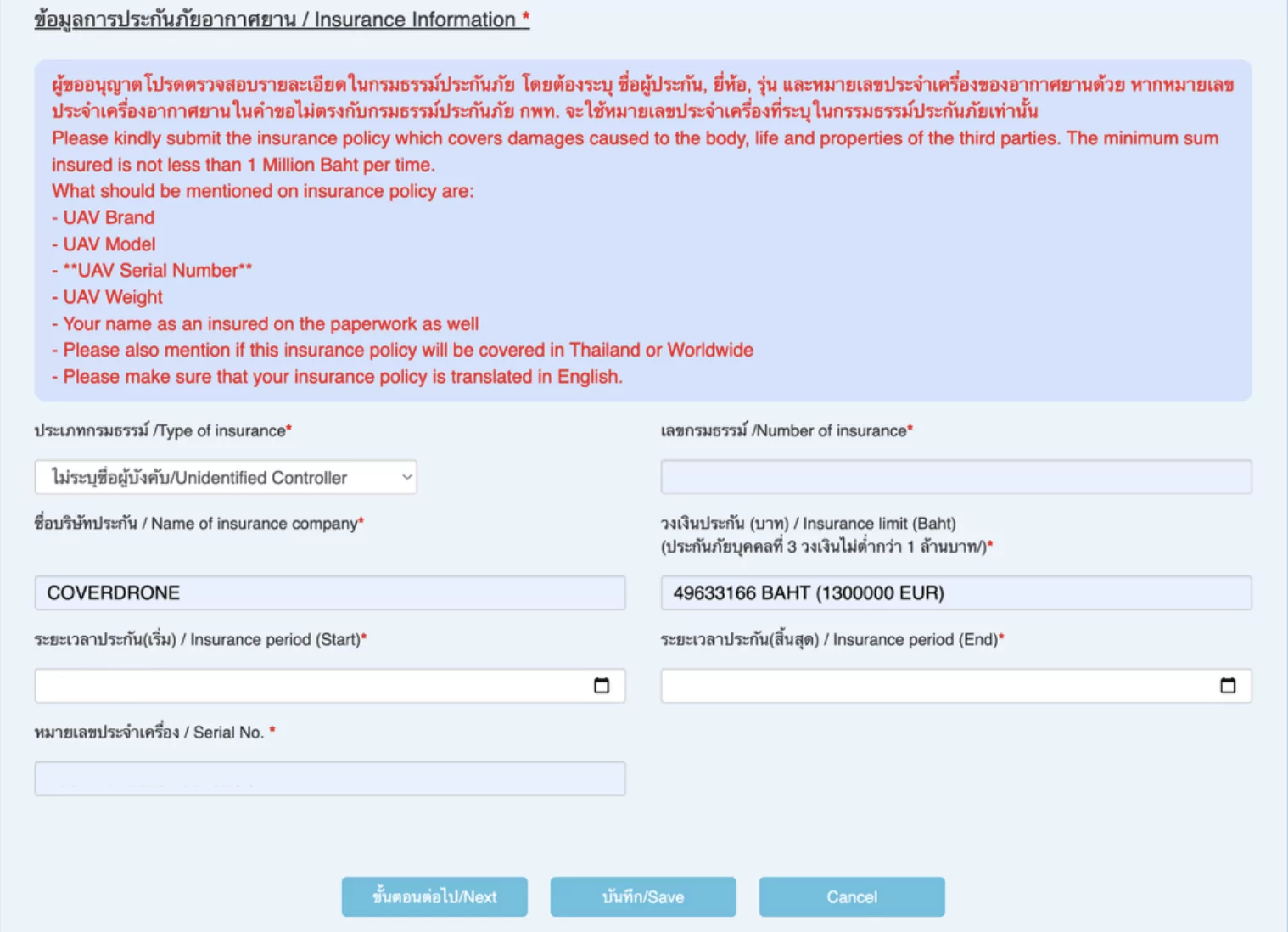
Fourth Step: Submission
- Click ‘Next,’ and prepare a single PDF file with all your documents in order:
- Self-declaration form (filled and signed)
- Passport photo
- National ID photo
- Visa confirmation
- Drone insurance policy
- Photos of the drone and equipment, serial number visible.
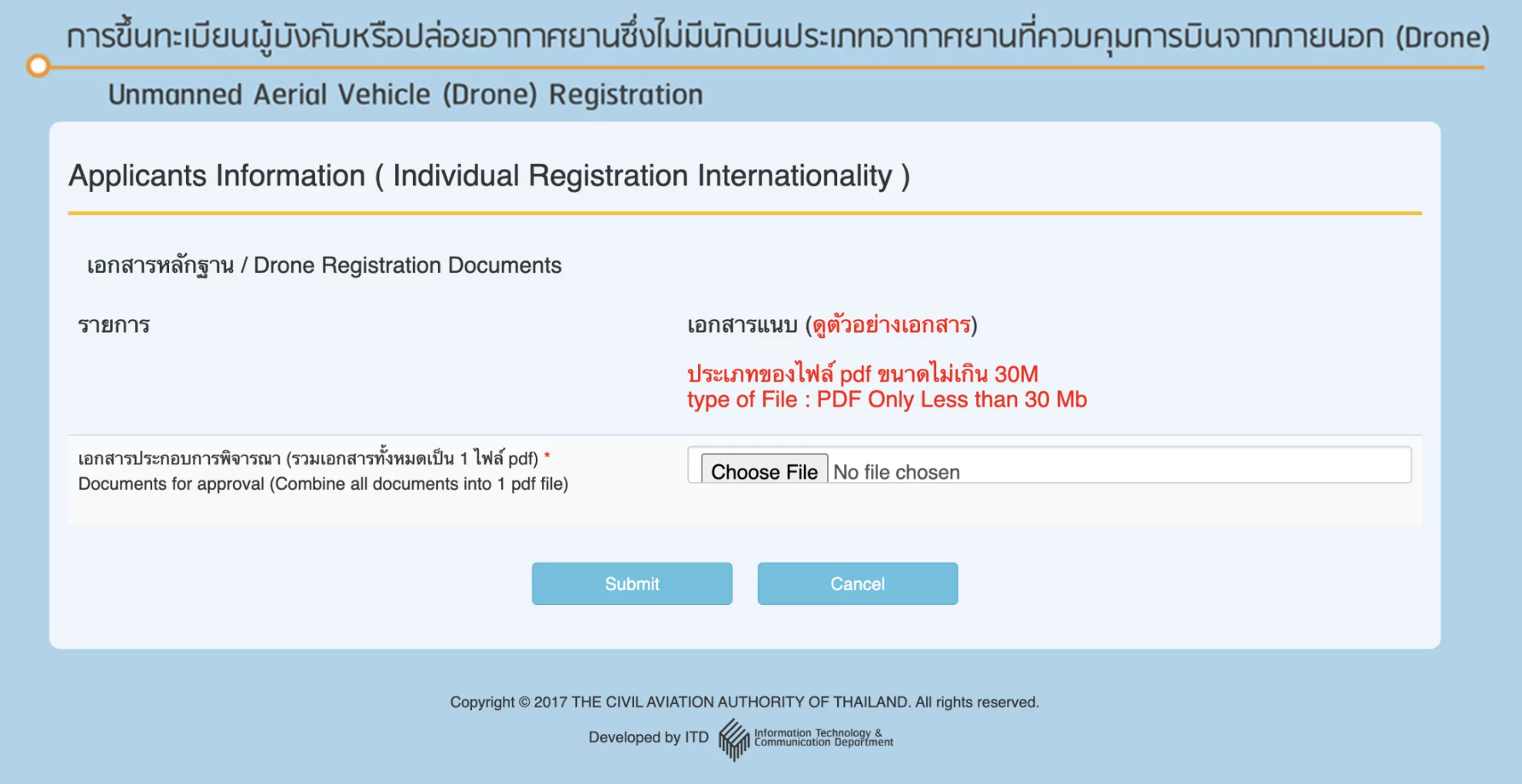
Pro Tips:
- Stay organized – your paperwork is your golden ticket.
- Double-check your details before hitting submit.
- Be patient; it’s a process, but we’re one step closer to legal drone adventures in Thailand!
NTBC Registration
Welcome to the final stretch of our drone registration saga – NTBC! This step involves a bit more on-the-ground action. Find below how to tackle the online NTBC registration process.
If you’re not in Thailand yet, no worries – you can still prep your documents. The catch? You’ll need to wait until you arrive to upload that entry passport stamp and make the payment in person. Here’s where you apply online: NTBC Online Application.
The registration process with NTBC, as mentioned on the website, should take 5-7 working days. We received our approval in 7 working days (but that is also due to having to re-check the application twice, first time because I didn’t write the address in the correct format, and the second time because I had to remove the Legal documents from the application). This registration is only valid until your visa end date.
First Step: Online Application Form
- Create an Account
- Jump on the NTBC website and create your account.
- Jump on the NTBC website and create your account.
- Fill in the online form with the following details:
- User Information: Details filled for CAAT plus your occupation.
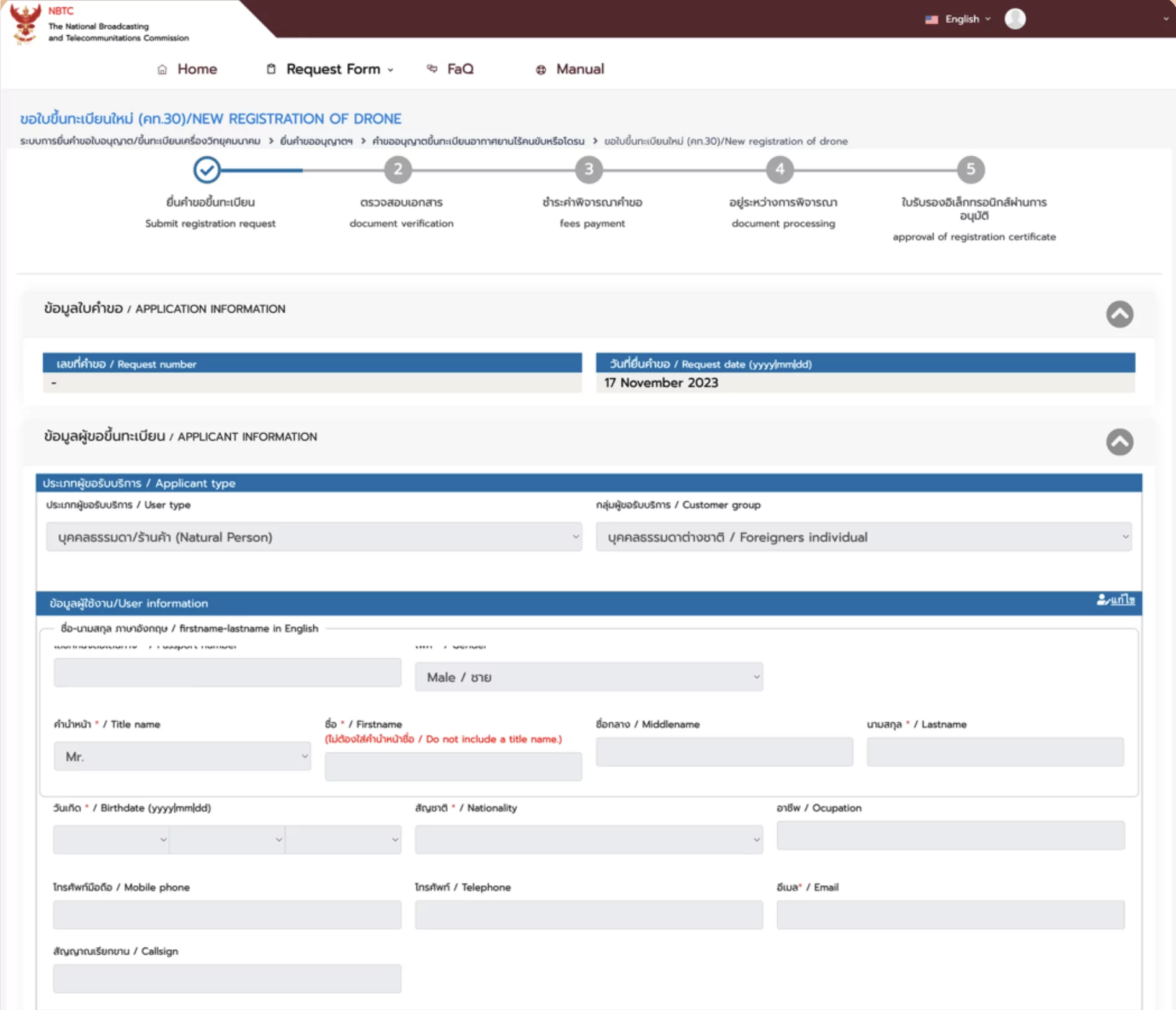
- Contact Address: Thailand address, province, district, sub-district, postal code.

- Date of Possession of a Radio Communications Device: I selected “temporarily imported into the country” and input my visa and arrival details.

- Information on External Flight Control Aircraft:
- Details about the drone: drone serial number, brand, model, installed accessories.
- Frequency and transmission power (I selected both 2400-2500 and 5725-5850 for my DJI MINI 3 PRO).
- Remote controller brand and serial number.
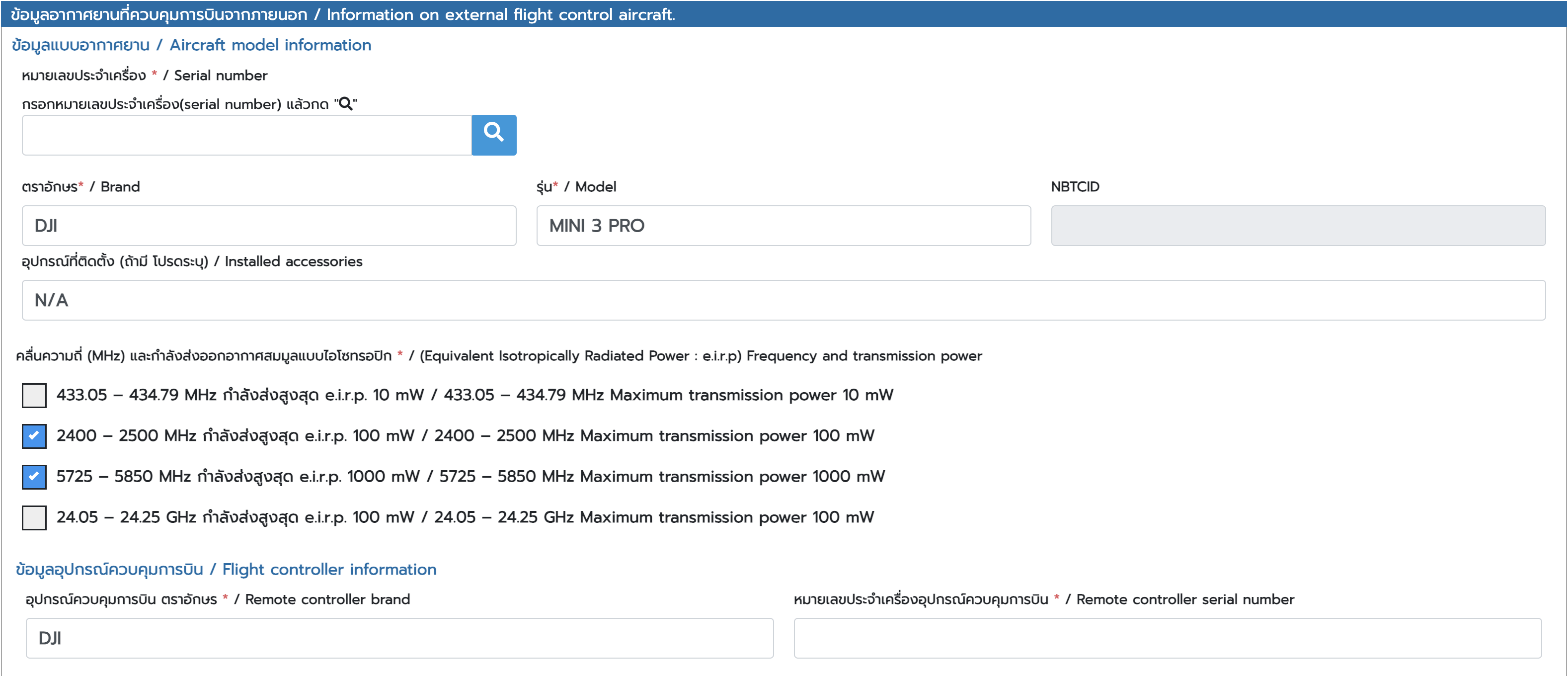
- Purpose of Using the Aircraft: I selected “Hobby, Entertainment, or Sport”.

Upload the necessary documents:
- Passport copy
- Visa copy
- Filled and Signed Form
- Drone photo
- Drone Serial number Photo
- Remote controller serial number photo
- Arrival immigration stamp (this is where you need that passport stamp photo upload)
- Points 3.1, 3.3 and 4 should not be completed
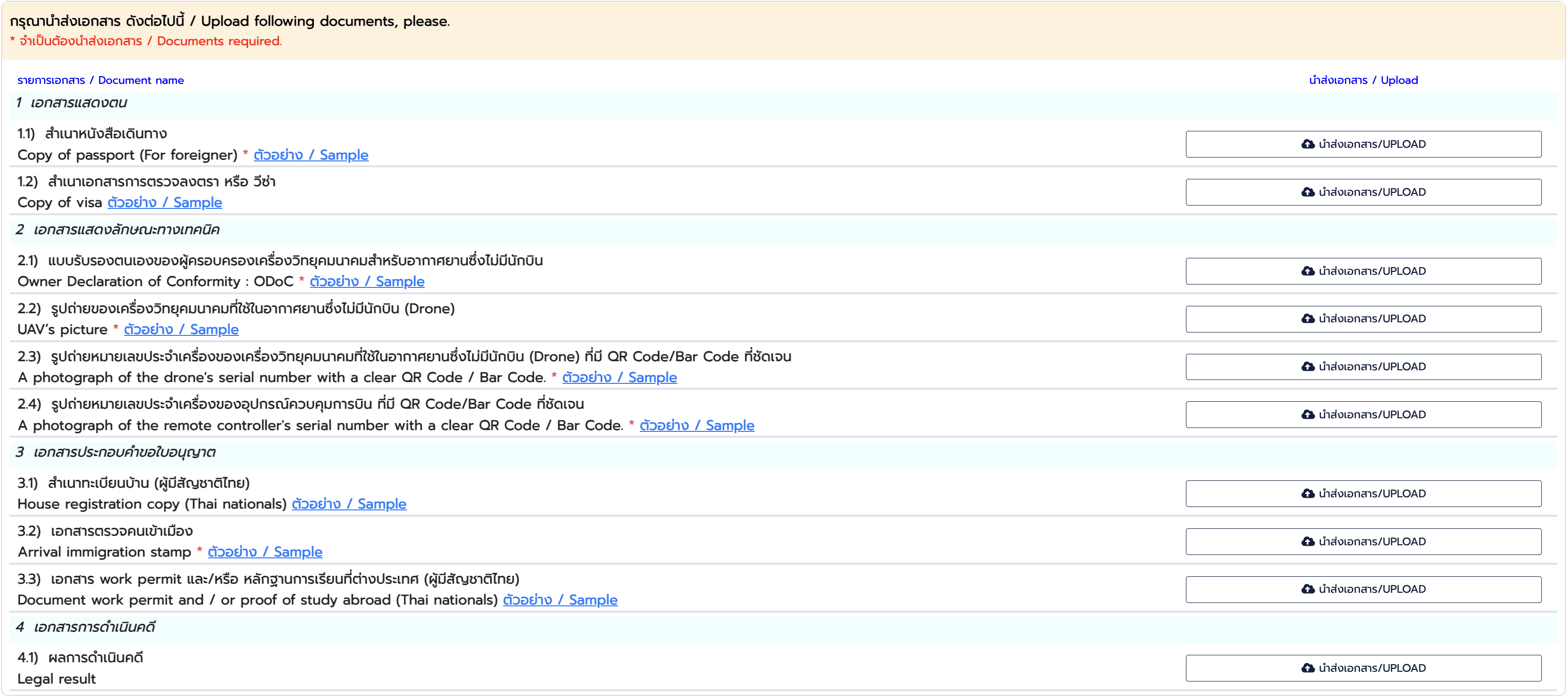
- Agree to terms and conditions.
- Choose the NTBC office where you want to submit your application (pick the one with the shortest queue).
- Hit that ‘Apply’ button.

Second Step: Pay the NTBC Registration fee
Once they approve your documents, you will receive an e-mail with a similar information to this:
Your UAV’S RADIO EQUIPMENT REGISTRATION request is “passed” in the data validation process and Document successfully
Remark:
The next step is to download the Bill Payment Pay-IN Slip from this link (and they’ll attach a link for the slip).
For applying to pay the fee Payment can be made at Kasikorn Bank PCL or cross-bank bill payment via electronic channels.
- Now, even if they say in the e-mail that the Payment can be made at Kasikorn Bank PCL, you actually have to go to Krung Thai Bank and pay the fee. After waiting for 30 minutes in the line at Kasikorn Bank PLC, they told me I have to pay at Krung Thai Bank.
- For the fee payment we needed:
- Cash: 214 THB (200 is the fee, 14 Tax)
- Passport
- Cash: 214 THB (200 is the fee, 14 Tax)
- The Pay-IN Slip (I had it on my phone and showed it to the cashier), which looks similar to the one below:
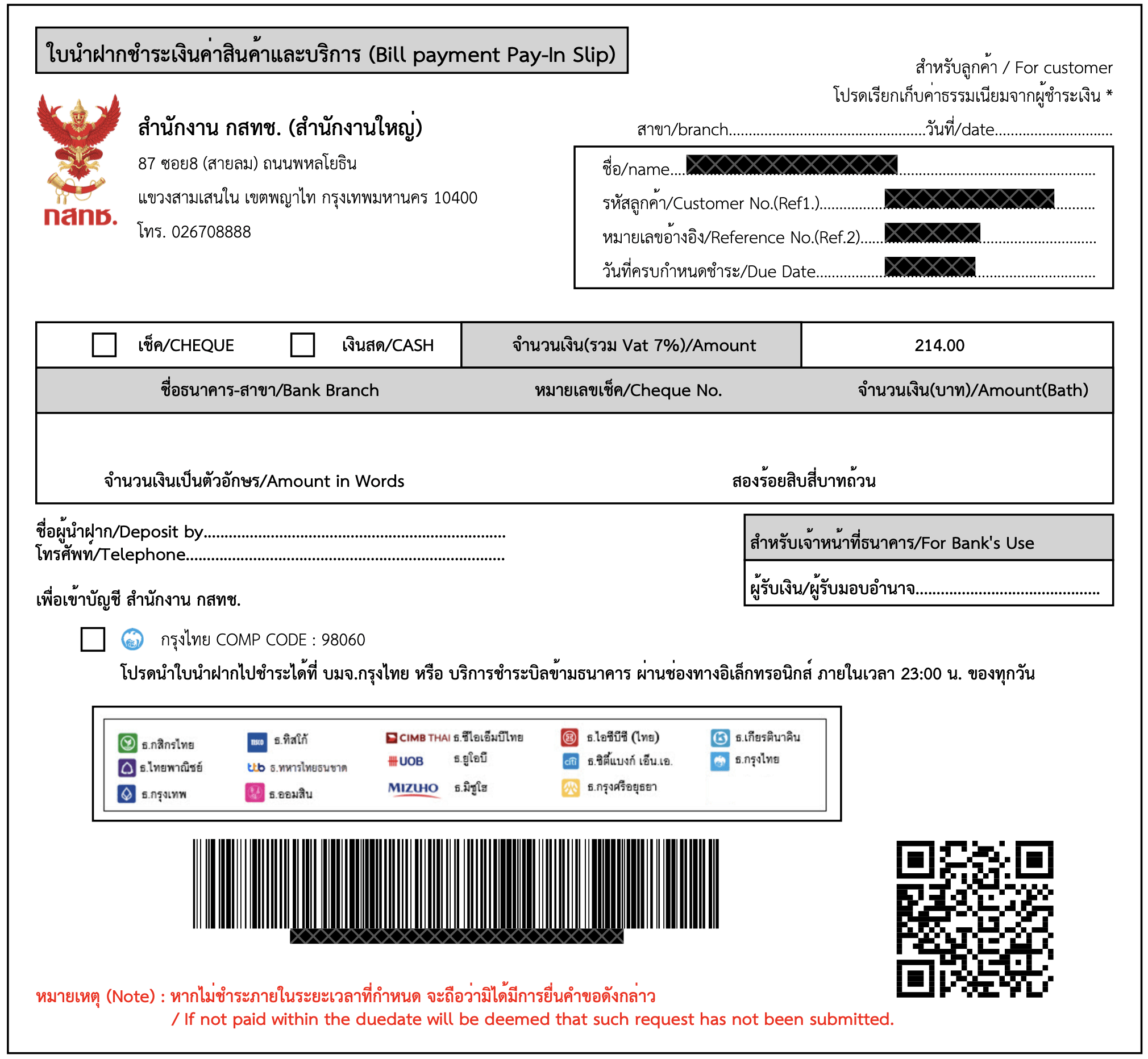
Third Step: Get your approval documents
- It took us around 2-3 hours from the moment we made the payment until we obtained our approval.
- You will receive an e-mail with the resolution and steps to download your registration certificate.
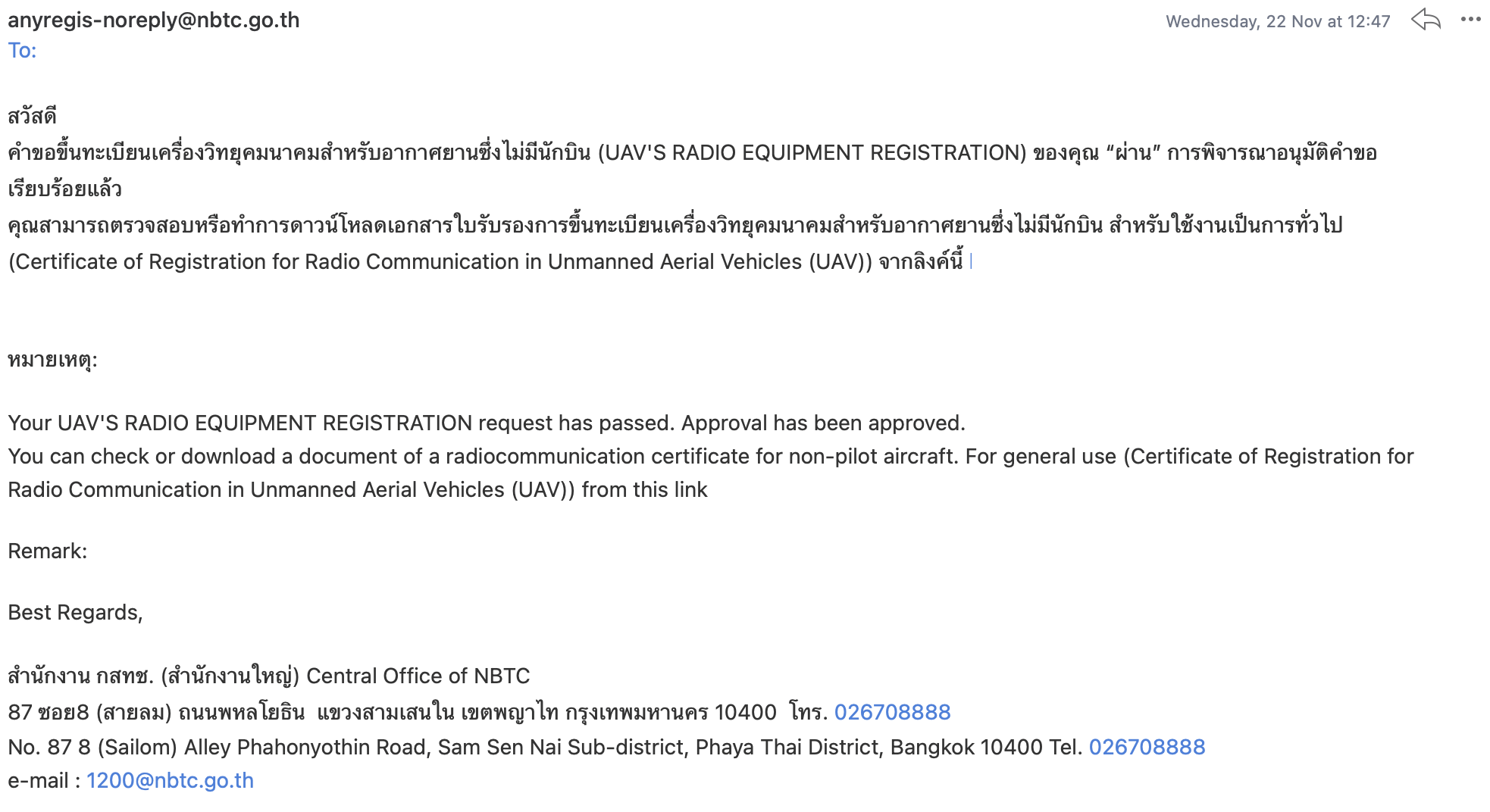
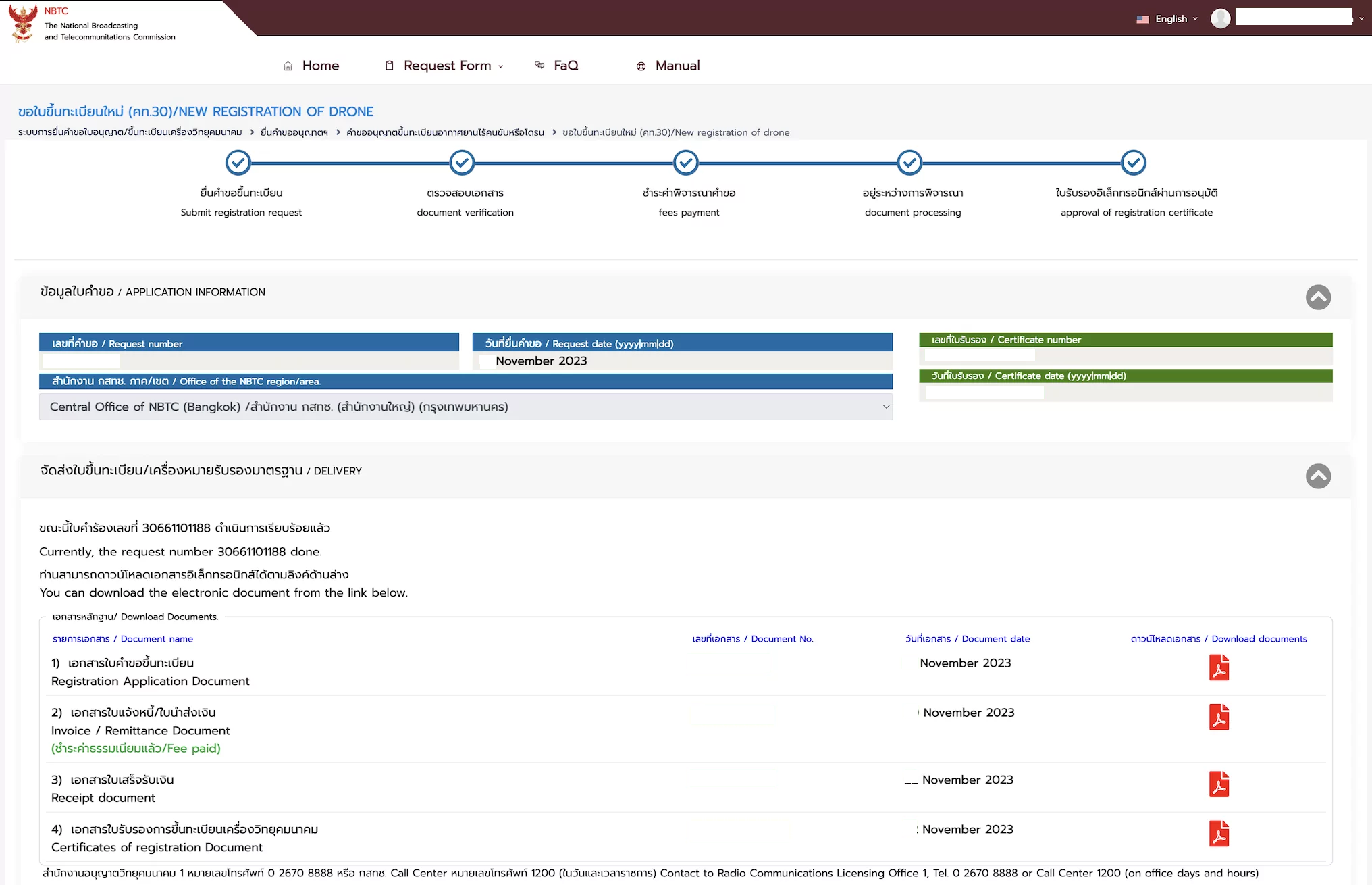
Pro Tips:
- Keep your cool; you’re almost there!
- Make sure your document uploads are clear and readable.
- Choose your NTBC office strategically for a smoother process.
- Pay only at a Krung Thai Bank branch.
The NTBC process can also be done physically at one of the NTBC offices. For this you will need to have copies of all the above-stated information, the proof of accommodation and to fill in these two forms: คท.30 and คท.32.
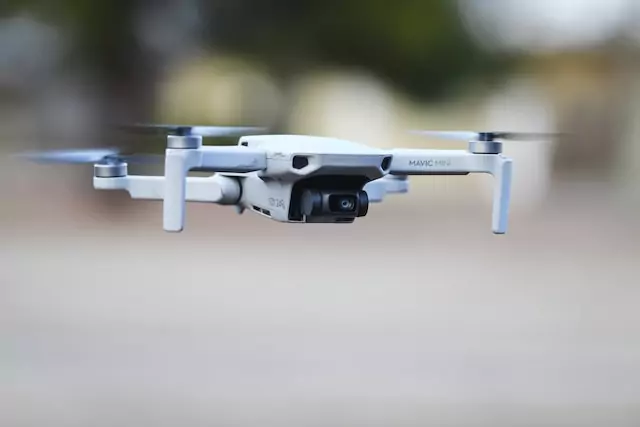
Flying Regulations: Responsible Skies
Even after successfully registering your drone in Thailand, it’s crucial to remember that responsible flying is the key to a safe and enjoyable experience. Here are some important regulations that every drone pilot must adhere to:
- Registration Requirement:
- Drones that weigh more than 25 kilograms (55 pounds) must be registered with the Minister of Transport.
- Visual Line of Sight:
- Drone pilots must maintain a visual line of sight with their drone at all times.
- Distance from Manned Aircraft:
- Drones must not be flown close to manned aircraft.
- Safe Distances:
- Drones must not be flown close to any person, vehicle, construction, or buildings at a distance less than 30 meters (98 feet) horizontally.
- A minimum distance of 50 meters is required from people, vehicles, and buildings.
- Avoid flying over cities and villages. Stay clear of government buildings and hospitals.
- Never fly near crowds of people.
- Restricted Areas:
- Drones must not be flown in restricted areas without authorization.
- Airport Regulations:
- Drones must not be flown within 9 kilometers (5 miles) from an airport or temporary airfield except with special authorization.
- Maintain a distance of 9 kilometers (= 5 miles) from airports.
- Altitude Restrictions:
- Drones must not be flown higher than 90 meters (295 feet).
- Permission for Takeoff and Landing:
- Always obtain permission from the property owner to take off and land. Typically, this can be resolved by asking guards for permission or inquiring at the information desk.
- Daylight Flight Only:
- Drone flights are only allowed in daylight in Thailand, between sunrise and sunset.
These regulations are in place to ensure the safety and privacy of individuals and property. By following these guidelines, you contribute to a positive drone community and a secure flying environment. Happy and responsible droning!
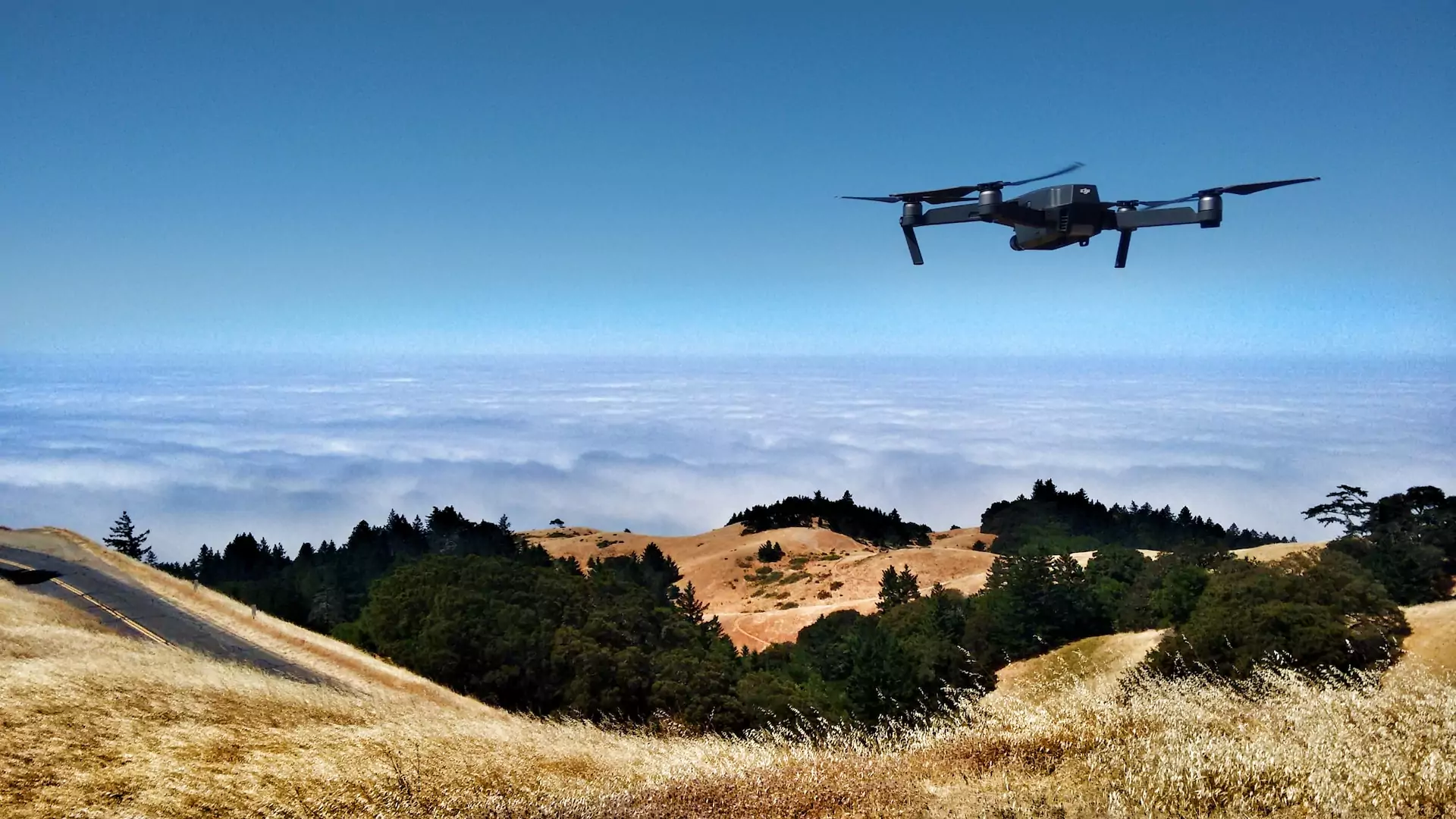
Conclusion: Soaring Above Legal Hurdles
Congratulations, fellow drone enthusiasts! You’ve navigated the twists and turns of Thailand’s drone registration like a pro. Now, armed with legal clearance and all the paperwork in order, your drone is ready to take flight and capture the breathtaking beauty of the Land of Smiles.
Remember, the key to hassle-free drone adventures in Thailand lies in meticulous planning and adherence to regulations. Obtaining a tourist visa, insuring your drone wisely, and successfully completing the CAAT and NTBC online drone registration in Thailand are crucial steps that ensure you not only comply with the rules but also experience the joy of flying your drone legally in this stunning country.
As the drone craze continues to elevate, Thailand’s evolving regulations may present new challenges. Stay informed, keep your documentation up-to-date, and always prioritize safety and responsibility in the skies.
So, here’s to smooth takeoffs, stunning aerial shots, and a drone adventure in Thailand that’s as legal as it is exhilarating. Happy droning, my friends, and may your flights be filled with wonder and awe!
* Affiliate Disclaimer: Some of the links in our articles are affiliate links. This means that if you click on the link and make a purchase, we may earn a commission at no additional cost to you. We only recommend products and services that we believe in and that we think will be useful for our readers.

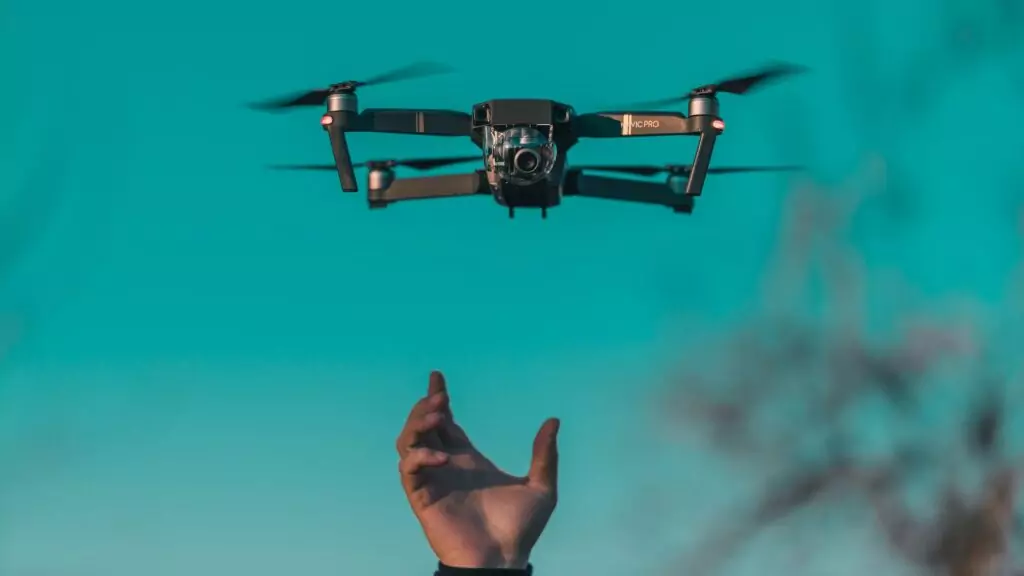










bonjour super article bien détaillé. je viens de faire toutes les démarches avec l’aide d’un bureau d’assurance très compétent qui se charge d’envoyer les documents aux compagnies concernées. Par contre je ne trouve pas de carte référençant les diverses zones ( interdites, reglementées….) pour voler avec le drone en Thailande.
Hello,
We check the DJI Fly app provided by our drone, and there you can see the map with restrictions. What drone do you use?